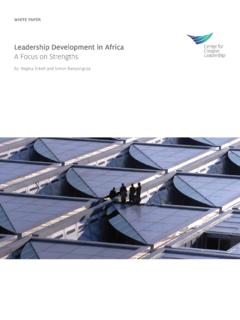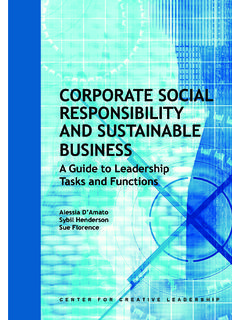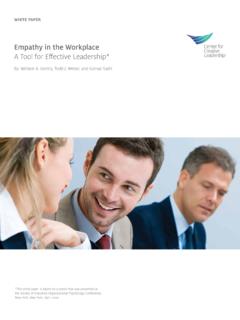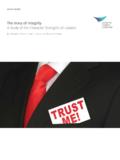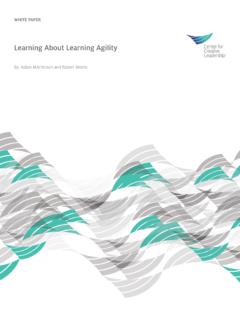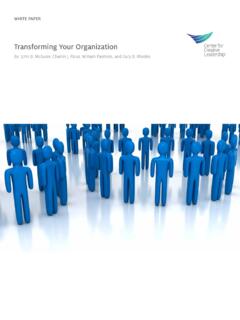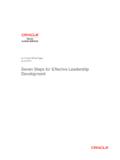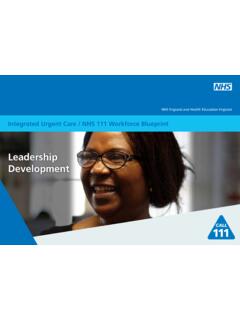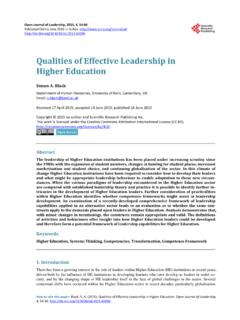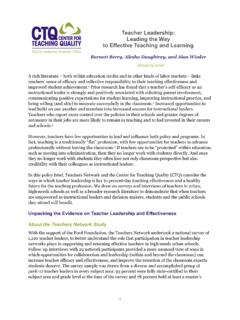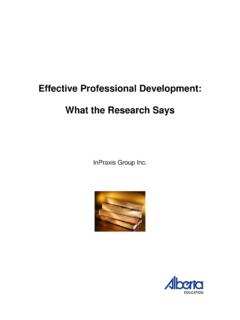Transcription of The Role of Power in Effective Leadership
1 A CCL Research White PaperThe Role of Power inEffective LeadershipBy: Vidula BalMichael CampbellJudith SteedKyle MeddingsCenter for Creative Leadership , CCL , and its logo are registered trademarks owned by the Center for Creative Leadership . 2008 Center for Creative Leadership . All rights reserved. The Role of Power in Effective LeadershipCENTER FOR CREATIVE LEADERSHIPCONTENTSE xecutive SummaryBackgroundPower and LeadershipSources of PowerThe Power of RelationshipsThe Power of InformationUnderstanding the Organization s Role How Leaders Leverage Power EffectivelyReflection QuestionsResourcesReferencesAbout the Authors45681214151719191920 The Role of Power in Effective LeadershipCenter for Creative Leadership , CCL , and its logo are registered trademarks owned by the Center for Creative Leadership .
2 2008 Center for Creative Leadership . All rights reserved. 4 EXECUTIVE SUMMARYThe Ideas2 Action (I2A) project is a Center for Creative Leadership (CCL ) initiative aimed at achieving its goal of ideas into action. The purpose of the project is to provide our participants and clientswith research that is timely and relevant to current challenges. Theresearch questions are also designed to aid in continuously updatingCCL program content and providing knowledge that is compelling toour participant purpose of this research is to understand how leaders use Power ,to learn about the situations in which Power is exerted and to describehow individuals and organizations can improve their Leadership throughthe Effective use of major findings of this research included:1. Most leaders surveyed (94 percent) rated themselves as being moderately to extremely powerful at work.
3 There is a notable correlation between leaders level in theorganization and how powerful they believe themselves to be at 28 percent of the leaders surveyed agree that Power is misused by top leaders intheir 59 percent of the leaders surveyed agree that their organization empowers people atall 41 percent of the leaders surveyed indicate that they would feel more powerful atwork if they had more formal The top three most frequently leveraged sources of Power are: the Power of expert-ise, the Power of information and the Power of relationships. The Power of punishment, or the ability to sanction individuals for failure to conform to standards orexpectations, is the least-leveraged source of Power . 6. The three sources of Power leaders believe will be most important to leverage in thenext five years are the Power of relationships, the Power of information, and the powerto reward The Power of relationships is most often used to promote one s own personal Leaders suggest that the Power of relationships can be better leveraged by identify-ing desired relationships, investing in those relationships, and repairing damaged relationships.
4 Center for Creative Leadership , CCL , and its logo are registered trademarks owned by the Center for Creative Leadership . 2008 Center for Creative Leadership . All rights reserved. The concepts of Power and Leadership have been and will continue to be interconnect-ed. While an individual may exert Power without being a leader, an individual cannotbe a leader without having Power . For this study, the I2A team defined Power simplyas the potential to influence others. This definition helps demystify Power and putsinto perspective the importance of using Power in order to be an Effective leader. In organizational settings, leaders must exert Power to achieve individual, team, andorganizational goals. Leaders must be able to influence their followers to achievegreater performance; their superiors and peers to make important decisions; and stake-holders to ensure the vitality of the WAS THE RESEARCH CONDUCTED?
5 During a five-month period of 2007, data were collected from participants attending aCCL program via two complementary research methods. The first asked participants tocomplete a short survey on computer kiosks during their weeklong participation in aCCL program. These data were returned to them by the end of their program second method was an Internet survey that participants volunteered to take part inapproximately two weeks following their CCL experience. This survey was more in-depth and allowed the I2A research team to better understand the high-level trendsthat emerged from the in-class PARTICIPATED IN THE RESEARCH?In-Class SurveyThe initial survey on Leadership Power focused on high-level trends and was completedby 260 participants attending a Leadership development program at CCL s ColoradoSprings, CO USA campus.
6 The typical participant was a male (73 percent), between theages of 36 and 50 years old (68 percent), representing upper-middle management or theexecutive level (64 percent).Post-Program SurveyApproximately two weeks following the CCL program, 45 participants who volun-teered received an Internet survey that posed qualitative questions about Power andleadership. The typical participant was male (64 percent), between the ages of 36 and 50(70 percent), at the executive level (43 percent).5 The Role of Power in Effective LeadershipBACKGROUNDMaleFemaleNot Identified73%24%3%DEMOGRAPHICS: GENDERIN-CLASS PERCENTAGEFIGURE 1 POST-PROGRAM PERCENTAGE64%36%Center for Creative Leadership , CCL , and its logo are registered trademarks owned by the Center for Creative Leadership . 2008 Center for Creative Leadership .
7 All rights reserved. 6 The Role of Power in Effective LeadershipWe wanted to gauge the perception leaders have of their own sense of Power . Based onthe sample of leaders surveyed, most recognize that they possess Power at work. There is also a notable correlation between how powerful a leader believes he or she isat work and that leader s level in the organization. Leaders at a higher organizationallevel tended to rate themselves as more powerful at work, while those lower in theorganizational hierarchy tended to rate themselves as less powerful. BACKGROUND (CONTINUED)26-3031-3536-4041-4546-5051-5 556-6061+1%8%19%24%25%14%8%1%DEMOGRAPHIC S: AGEIN-CLASS PERCENTAGEFIGURE 2 POST-PROGRAM PERCENTAGE2%9%25%25%20%11%8%Fi rst Leve lMiddle ManagementUpper Middle ManagementExecutiveTop ManagementNot Identified1%17%28%36%15%3%DEMOGRAPHICS: LEVEL IN ORGANIZATIONIN-CLASS PERCENTAGEFIGURE 3 POST-PROGRAM PERCENTAGE2%30%16%43%9% Power AND LEADERSHIPC enter for Creative Leadership , CCL , and its logo are registered trademarks owned by the Center for Creative Leadership .
8 2008 Center for Creative Leadership . All rights reserved. 7 The Role of Power in Effective LeadershipPOWER AND Leadership (CONTINUED)We also sought to understand how Power is perceived within organizations. The dataindicate some tensions around distribution of Power . Most of the survey respondents (59 percent agreement) believe that their organizationswork to empower their people at all levels, and 53 percent of those surveyed agreedthat their organization rewards leaders for empowering people. Even so, over half (55 percent agreement) stated that Power is concentrated among afew select individuals in their organization. Twenty-eight percent of survey participantsagreed that Power is misused by top leaders within their organizations. Only 29 percent believed that their organizations teach their leaders how to effectivelyleverage their full organizational trends relative to Power and Leadership suggest that while poweris not typically misused by top leaders, it does tend to be concentrated to a select fewindividuals.
9 However, the flatter organizational structures and self-directed work teamsthat were first implemented through the empowerment movements of the 1980s and1990s are becoming commonplace. This trend may increase the level of empowermentthat employees experience in future also reward leaders who empower the people they lead, thereby encour-aging overall employee empowerment; however, fewer organizations take the opportu-nity to teach leaders how to effectively use the Power they possess. This leaves the defi-nition of appropriate and Effective use of Power largely up to individual powerful do you think you are at work? Survey participants were askedto rate how powerful they think they are at work on a 1 to 7 scale where 1equals Not at all Powerful and 7 equals Extremely Powerful.
10 5%5%FIGURE 4 Center for Creative Leadership , CCL , and its logo are registered trademarks owned by the Center for Creative Leadership . 2008 Center for Creative Leadership . All rights reserved. 8 The Role of Power in Effective LeadershipPOWER AND Leadership (CONTINUED)My organization empowers people at all my organization, Power is concentrated in thehands of a few select organization rewards leaders for empowering organization teaches leaders how to leveragetheir full is misused by top leaders in my AGREEFIGURE 5 The Perception of Power . Survey participants were asked whether they agreeor disagree with a number of statements about Power in their most people think about Power , their minds go immediately to the control thathigh-level leaders exert from their positions atop the organizational hierarchy.


